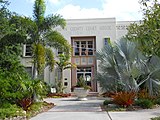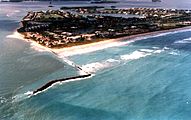Martin County, Florida
Martin County | |
|---|---|
 Martin County Courthouse | |
 Location within the U.S. state of Florida | |
 Florida's location within the U.S. | |
| Coordinates: 27°05′N 80°24′W / 27.08°N 80.4°W | |
| Country | |
| State | |
| Founded | May 30, 1925 |
| Named for | John W. Martin |
| Seat | Stuart |
| Largest community | Palm City |
| Area | |
| • Total | 753 sq mi (1,950 km2) |
| • Land | 543 sq mi (1,410 km2) |
| • Water | 209 sq mi (540 km2) 27.8% |
| Population (2013) | |
| • Total | 151,263 |
| • Density | 269/sq mi (104/km2) |
| Time zone | UTC−5 (Eastern) |
| • Summer (DST) | UTC−4 (EDT) |
| Congressional district | 18th |
| Website | www |

Martin County is a county located in the Treasure Coast region in the U.S. state of Florida. As of the 2010 census, the population was 146,318.[1] Its county seat is Stuart.[2]
Martin County is included in the Port St. Lucie, FL Metropolitan Statistical Area, which is also included in the Miami-Fort Lauderdale-Port St. Lucie, FL Combined Statistical Area.
History
Martin County was created in 1925 with the northern portion coming from St. Lucie County and southern portion coming from Palm Beach County. It was named for John W. Martin, Governor of Florida from 1925 to 1929.
When the county was created, the western contour followed the shore of Lake Okeechobee, as did the borders of Glades, Okeechobee, and Hendry counties. Palm Beach County had historically claimed all of the surface of the lake as part of its area, to its benefit for the distribution of state and federal highway funds. The state representative of Martin County, William Ralph Scott of Stuart, initiated a bill to divide the lake among its adjacent counties, creating a more equitable distribution of state funds for road creation and maintenance. All bordering counties confirmed the justice of this change and supported its ratification, with the exception of Palm Beach County. Representatives from Palm Beach County later presented Representative William Scott with a jug of water, signifying "all the water Bill Scott left Palm Beach County." The jug is in the possession of Stuart Heritage.
The unusual feature of the point of the meeting of five counties in the largest freshwater body of water in the South may be the only one of its kind.
Geography
According to the U.S. Census Bureau, the county has a total area of 753 square miles (1,950 km2), of which 543 square miles (1,410 km2) is land and 209 square miles (540 km2) (27.8%) is water.[3] It is the fifth-largest county in Florida by land area, and fifty-third largest by total area.
Major highways
Adjacent counties
- St. Lucie County – north
- Palm Beach County – south
- Hendry County – southwest
- Glades County – southwest
- Okeechobee County – northwest
National protected area
Demographics
| Census | Pop. | Note | %± |
|---|---|---|---|
| 1930 | 5,111 | — | |
| 1940 | 6,295 | 23.2% | |
| 1950 | 7,807 | 24.0% | |
| 1960 | 16,932 | 116.9% | |
| 1970 | 28,035 | 65.6% | |
| 1980 | 64,014 | 128.3% | |
| 1990 | 100,900 | 57.6% | |
| 2000 | 126,731 | 25.6% | |
| 2010 | 146,318 | 15.5% | |
| 2013 (est.) | 151,263 | 3.4% | |
1790-1960[5] 1900-1990[6] 1990-2000[7] 2010-2013[1] | |||
As of the census[8] of 2000, there were 126,731 people, 55,288 households, and 36,213 families residing in the county. The population density was 228 per square mile (88/km2). There were 65,471 housing units at an average density of 118 per square mile (46/km2). The racial makeup of the county was 89.88% White, 5.27% Black or African American, 0.30% Native American, 0.60% Asian, 0.10% Pacific Islander, 2.72% from other races, and 1.14% from two or more races. 7.50% of the population were Hispanic or Latino of any race.
In 2000 there were 55,288 households out of which 21.50% had children under the age of 18 living with them, 55.00% were married couples living together, 7.40% had a female householder with no husband present, and 34.50% were non-families. 29.00% of all households were made up of individuals and 16.00% had someone living alone who was 65 years of age or older. The average household size was 2.23 and the average family size was 2.71.
In the county the population was spread out with 18.60% under the age of 18, 5.30% from 18 to 24, 22.90% from 25 to 44, 24.90% from 45 to 64, and 28.20% who were 65 years of age or older. The median age was 47 years. For every 100 females there were 96.40 males. For every 100 females age 18 and over, there were 94.20 males.
The median income for a household in the county was $43,083, and the median income for a family was $53,244. Males had a median income of $36,133 versus $27,000 for females. The per capita income for the county was $29,584. About 5.60% of families and 8.80% of the population were below the poverty line, including 13.80% of those under age 18 and 5.20% of those age 65 or over.
Government
Martin County is a non-chartered county and its form of government is prescribed by the Florida Constitution and Florida Statutes, as follows:
Board of County Commissioners

The Board of County Commissioners is the legislative body of the county and has charge of all county executive and administrative functions, except those assigned by the Constitution to independent county officers or to the independent school district. The board also has some quasi-judicial functions. Some of functions exercised by the board are county-wide, while others are applicable only in the unincorporated areas of the county, where the board has many of the functions of a municipality. The county commissioners are elected by county-wide vote, but each one represents a specific district. The board appoints the county administrator who is responsible to it for the day-to-day operations of the county government. The current county commissioners by district number are:
- 1. Doug Smith
- 2. Ed Fielding, Vice Chair
- 3. Anne Scott
- 4. Sarah Heard, Chair
- 5. John Haddox
Constitutional Officers
The elected Constitutional Officers are:
- Clerk (Clerk of Courts, County Clerk, etc.): Carolyn Timmann
- Property Appraiser: Laurel Kelly
- Sheriff: William Snyder
- Supervisor of Elections: Vicki Davis
- Tax Collector: Ruth Pietruszewski
School District
The independent Martin County School District has an elected Superintendent of Schools and elected School Board, as follows:
- The Superintendent, Laurie Gaylord (R), is the chief administrator of the district.
- The School Board is the legislative body of the district and also exercises quasi-judicial powers. School Board members are elected county wide but each one represents a specific district. The current board members by district are:
- 1. Michael Busha, Co-chair
- 2. Marsha Powers
- 3. Rebecca Negron
- 4. Maura Barry-Sorenson, Chair
- 5. Michael DiTerlizzi
Libraries
The Martin County Library System has 7 branches.
- Blake Library
- Elizabeth Lahti Library
- Hobe Sound Public Library
- Hoke Library
- Peter & Julie Cummings Library
- Robert Morgade Library
- Law Library
Attractions

- Audubon of Martin County: Possum Long Nature Center, Palm Beach Road, Stuart[9]
- Elliott Museum on Hutchinson Island
- Jonathan Dickinson State Park in South Martin County
- Martin County Fair held every February.
- Martin County Public Beaches:
- Hobe Sound Public Beach on Jupiter Island
- Jensen Sea Turtle Beach, Stuart Beach and many beach strips on Hutchinson Island.
- Savannas Preserve State Park (extends into St. Lucie County)
- St. Lucie Inlet Preserve State Park on Long Island east of Port Salerno and north of Jupiter Island
Historic areas
On the National Register of Historic Places:
- Hobe Sound
- Olympia School, 1925
- Trapper Nelson Zoo Historic District, located south of Hobe Sound is inside Jonathan Dickinson State Park in southern Martin County, 1933
- Hutchinson Island
- Indiantown
- Seminole Inn, 1926
- Jensen Beach
- Mount Elizabeth Archeological Site, prehistoric
- Stuart Welcome Arch, 1926
- Tuckahoe, 1938
- Jupiter Island
- Gate House, 1927
- Stuart
- Burn Brae Plantation-Krueger House, 1894
- Lyric Theatre, 1927
- Old Martin County Courthouse, 1937
Other historic areas listed in 1989 by the Florida Chapter of the American Institute of Architects:[10]
- All Saints Episcopal Church, Waveland, 2377 N.E. Patrician Street, 1898,
- Bay Tree Lodge (Kiplinger House), 143 S. River Road (originally 104 S. Sewall's Point Road), Sewall's Point, 1909
- Dudley-Bessey House, 110 S.W. Atlanta Avenue, Stuart, 1909
- Dyer Homestead, 1006 S.W. St. Lucie Crescent, Stuart, 1904
- Feroe Building, 73 S.W. Flagler Avenue, corner of St. Lucie, Stuart, 1913
- France Apartments, 524 St. Lucie Crescent, Stuart, 1927
- Golden Gate Building, 3225 S.E. Dixie Highway in Golden Gate south of Stuart, 1925
- Kitching House, 210 S.W. Atlanta Avenue, Stuart, 1894
- Stuart Feed Store, 101 S.W. Flagler Avenue, Stuart, 1905
- Sunrise Inn, S.E. Old St. Lucie Boulevard, Port Sewall. ca. 1925 (demolished)
- John E. Taylor House, 204 S.E. Atlanta Avenue, Stuart, 1914
Other places listed in 2012 by the Florida Chapter of the American Institute of Architects in its Florida Architecture: 100 Years. 100 Places.[11]
- Beach Road 2, Jupiter Island
Communities

City
Towns
Unincorporated communities

- Hobe Sound
- Hutchinson Island part
- Indiantown
- Jensen Beach
- North River Shores
- Palm City
- Port Salerno
- Rio
- Port Mayaca
Gallery
-
The Gazebo on the grounds of the new courthouse complex
-
The Old Martin County Courthouse, built in 1937
-
Golden Gate Building, built in 1925
-
View of St. Lucie River and Stuart from Sewall's Point
-
View of St. Lucie Inlet and Sailfish Point
-
St. Lucie Locks and Dam
See also
References
- ^ a b "State & County QuickFacts". United States Census Bureau. Retrieved February 14, 2014.
- ^ "Find a County". National Association of Counties. Retrieved 2011-06-07.
- ^ "US Gazetteer files: 2010, 2000, and 1990". United States Census Bureau. 2011-02-12. Retrieved 2011-04-23.
- ^ "U.S. Decennial Census". United States Census Bureau. Retrieved June 15, 2014.
- ^ "Historical Census Browser". University of Virginia Library. Retrieved June 15, 2014.
- ^ "Population of Counties by Decennial Census: 1900 to 1990". United States Census Bureau. Retrieved June 15, 2014.
- ^ "Census 2000 PHC-T-4. Ranking Tables for Counties: 1990 and 2000" (PDF). United States Census Bureau. Retrieved June 15, 2014.
- ^ "American FactFinder". United States Census Bureau. Retrieved 2011-05-14.
- ^ Audubon of Martin County: Possum Long Nature Center
- ^ A Guide to Florida's Historic Architecture, 1989, Gainesville: University of Florida Press, p. 137, ISBN 0-8130-0941-3
- ^ Current standings: Florida Architecture: 100 Years. 100 Places
External links
Governmental
- Board of County Commissioners
- Constitutional officers of Martin County
- School district
- Multi-county Districts
- Judicial branch








